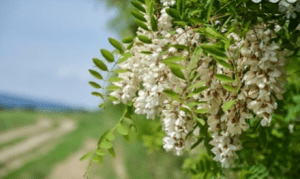If you’re struck with a heavenly fragrance while outdoors this weekend, look around and chances are you’ll see Black Locust trees covered in their drooping white blooms. This nearly-native, but well-naturalized tree covers abundant chunks of our landscape wherever there was once farming. 
The beauty of Black Locust extends well beyond its flowers. This fast-growing tree from the Legume family enriches soils and produces lumber that is excellent for firewood, fine carpentry, and applications that require extreme durability. If locust were more abundant, we could use it to largely displace chemically-treated pine imported from other regions of the country. It is also one of the few, if not only, tree species that can be grown as a cash crop – that is, profitably – here in Finger Lakes making it it a sound choice for reforesting old fields.
Early arrivers to North America recognized Black Locust’s many attributes and took it back to the Old Country three centuries ago. Since then, it has become the predominant reforestation tree in many European countries and extensive work has been done on its genetic improvement. Looking to benefit from some of that work, a group of CCE foresters imported seed from Hungary in 2015 and began propagation of this and other improved strains. Next spring we will establish the first “seed orchard” of superior trees at Cornell’s Arnot Forest as a source of genetic material for those seeking straighter and more pest-resistant Black Locust. To learn more about these efforts, visit our forestry forum at: www.cornellforestconnect.ning.com and use the search box to find relevant posts, including the proceedings from our 2017 Black Locust Conference.
Brought to you by:
Brett Chedzoy
Senior Resource Educator in Agriculture and Natural Resources
bjc226@cornell.edu



